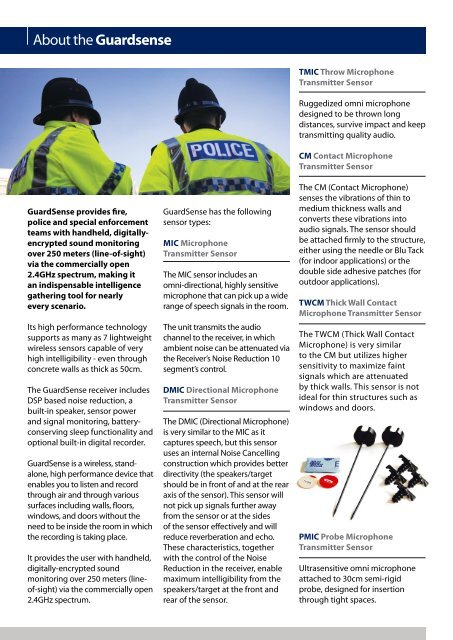GUARDSENSE Wireless Through-Wall Audio - Winkelmann (UK)
GUARDSENSE Wireless Through-Wall Audio - Winkelmann (UK)
GUARDSENSE Wireless Through-Wall Audio - Winkelmann (UK)
You also want an ePaper? Increase the reach of your titles
YUMPU automatically turns print PDFs into web optimized ePapers that Google loves.
About the Guardsense<br />
GuardSense provides fire,<br />
police and special enforcement<br />
teams with handheld, digitallyencrypted<br />
sound monitoring<br />
over 250 meters (line-of-sight)<br />
via the commercially open<br />
2.4GHz spectrum, making it<br />
an indispensable intelligence<br />
gathering tool for nearly<br />
every scenario.<br />
Its high performance technology<br />
supports as many as 7 lightweight<br />
wireless sensors capable of very<br />
high intelligibility - even through<br />
concrete walls as thick as 50cm.<br />
The GuardSense receiver includes<br />
DSP based noise reduction, a<br />
built-in speaker, sensor power<br />
and signal monitoring, batteryconserving<br />
sleep functionality and<br />
optional built-in digital recorder.<br />
GuardSense is a wireless, standalone,<br />
high performance device that<br />
enables you to listen and record<br />
through air and through various<br />
surfaces including walls, floors,<br />
windows, and doors without the<br />
need to be inside the room in which<br />
the recording is taking place.<br />
It provides the user with handheld,<br />
digitally-encrypted sound<br />
monitoring over 250 meters (lineof-sight)<br />
via the commercially open<br />
2.4GHz spectrum.<br />
GuardSense has the following<br />
sensor types:<br />
Mic Microphone<br />
Transmitter Sensor<br />
The MIC sensor includes an<br />
omni-directional, highly sensitive<br />
microphone that can pick up a wide<br />
range of speech signals in the room.<br />
The unit transmits the audio<br />
channel to the receiver, in which<br />
ambient noise can be attenuated via<br />
the Receiver’s Noise Reduction 10<br />
segment’s control.<br />
DMic Directional Microphone<br />
Transmitter Sensor<br />
The DMIC (Directional Microphone)<br />
is very similar to the MIC as it<br />
captures speech, but this sensor<br />
uses an internal Noise Cancelling<br />
construction which provides better<br />
directivity (the speakers/target<br />
should be in front of and at the rear<br />
axis of the sensor). This sensor will<br />
not pick up signals further away<br />
from the sensor or at the sides<br />
of the sensor effectively and will<br />
reduce reverberation and echo.<br />
These characteristics, together<br />
with the control of the Noise<br />
Reduction in the receiver, enable<br />
maximum intelligibility from the<br />
speakers/target at the front and<br />
rear of the sensor.<br />
TMic Throw Microphone<br />
Transmitter Sensor<br />
Ruggedized omni microphone<br />
designed to be thrown long<br />
distances, survive impact and keep<br />
transmitting quality audio.<br />
cM contact Microphone<br />
Transmitter Sensor<br />
The CM (Contact Microphone)<br />
senses the vibrations of thin to<br />
medium thickness walls and<br />
converts these vibrations into<br />
audio signals. The sensor should<br />
be attached firmly to the structure,<br />
either using the needle or Blu Tack<br />
(for indoor applications) or the<br />
double side adhesive patches (for<br />
outdoor applications).<br />
TWcM Thick <strong>Wall</strong> contact<br />
Microphone Transmitter Sensor<br />
The TWCM (Thick <strong>Wall</strong> Contact<br />
Microphone) is very similar<br />
to the CM but utilizes higher<br />
sensitivity to maximize faint<br />
signals which are attenuated<br />
by thick walls. This sensor is not<br />
ideal for thin structures such as<br />
windows and doors.<br />
PMic Probe Microphone<br />
Transmitter Sensor<br />
Ultrasensitive omni microphone<br />
attached to 30cm semi-rigid<br />
probe, designed for insertion<br />
through tight spaces.


